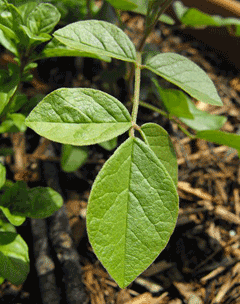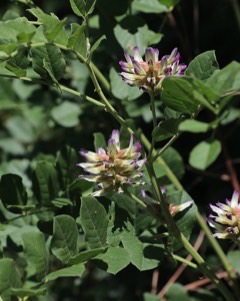 |
|
|
 |
| Michael Wolf, Penig. wikimedia.org |
Translate this page:
Summary
Physical Characteristics

 Glycyrrhiza uralensis is a PERENNIAL growing to 0.6 m (2ft) by 0.4 m (1ft 4in).
Glycyrrhiza uralensis is a PERENNIAL growing to 0.6 m (2ft) by 0.4 m (1ft 4in).
See above for USDA hardiness. It is hardy to UK zone 6. It is in flower from June to August, and the seeds ripen from July to October. The species is hermaphrodite (has both male and female organs).
It can fix Nitrogen.
Suitable for: light (sandy), medium (loamy) and heavy (clay) soils. Suitable pH: mildly acid, neutral and basic (mildly alkaline) soils. It can grow in semi-shade (light woodland) or no shade. It prefers moist soil.
UK Hardiness Map
US Hardiness Map
Synonyms
Plant Habitats
Cultivated Beds;
Edible Uses
Edible Parts: Root
Edible Uses: Sweetener
The fibrous root is used as a sweetener for foods[183]. It is boiled in water to extract the sugars etc and used as a liquorice substitute in sweets, medicines, drinks etc[74, 174, 177]. The root contains glycyrrhizin, which is 50 times sweeter than sugar[218].
References More on Edible Uses
Medicinal Uses
Plants For A Future can not take any responsibility for any adverse effects from the use of plants. Always seek advice from a professional before using a plant medicinally.
Antiphlogistic Antispasmodic Antitussive Cholagogue Emollient Expectorant
Gan Cao is commonly used in Chinese herbalism, where it is considered to be one of the 50 fundamental herbs[218]. It is considered to be second in importance only to Ginseng (Panax spp)[218]. Used in excess, however, it can cause cardiac dysfunction and severe hypertension[218]. The root is a sweet tonic herb that stimulates the corticosteroidal hormones, neutralizes toxins and balances blood sugar levels[238]. It is also antibacterial, anti-inflammatory, antiphlogistic, antispasmodic, antitussive, cholagogue, demulcent, emollient, expectorant and laxative[61, 176, 218, 238]. It is used internally in the treatment of Addison's disease, asthma, coughs and peptic ulcers[238]. Externally, it is used to treat acne, boils and sore throats[238]. It is included in almost all Chinese herbal formulae, where it is said to harmonize and direct the effects of the various ingredients[238]. It precipitates many compounds and is therefore considered to be unsuitable for use with some herbs such as Daphne genkwa, Euphorbia pekinensis and Corydalis solida[238]. It increases the toxicity of some compounds such as ephedrine, salicylates, adrenaline and cortisone[238]. It should not be prescribed for pregnant women or for people with high blood pressure, kidney disease or anyone taking digoxin-based medications[238]. Excessive doses cause water retention and high blood pressure[238]. It can cause impotence in some people[238]. The roots are harvested in early autumn, preferably from plants 3- 4 years old, and is dried for later use[238]. The flowers are alterative and expectorant[218].
References More on Medicinal Uses
The Bookshop: Edible Plant Books
Our Latest books on Perennial Plants For Food Forests and Permaculture Gardens in paperback or digital formats.

Edible Tropical Plants
Food Forest Plants for Hotter Conditions: 250+ Plants For Tropical Food Forests & Permaculture Gardens.
More

Edible Temperate Plants
Plants for Your Food Forest: 500 Plants for Temperate Food Forests & Permaculture Gardens.
More

More Books
PFAF have eight books available in paperback and digital formats. Browse the shop for more information.
Shop Now
Other Uses
Fire retardant Insulation
Liquorice root, after the medicinal and flavouring compounds have been removed, is used in fire extinguishing agents, to insulate fibreboards and as a compost for growing mushrooms[218]. Nitrogen fixer. A dynamic accumulator gathering minerals or nutrients from the soil and storing them in a more bioavailable form - used as fertilizer or to improve mulch.
Special Uses
Dynamic accumulator Dynamic accumulator Food Forest Nitrogen Fixer
References More on Other Uses
Cultivation details
Requires a deep well cultivated fertile moisture-retentive soil for good root production[200]. Prefers a sandy soil with abundant moisture[238]. Slightly alkaline conditions produce the best plants[238]. Plants are hardy to at least -15°c[238]. This species is widely cultivated in China as a medicinal plant. Unless seed is required, the plant is usually prevented from flowering so that it puts more energy into producing good quality roots[238]. A very deep-rooted plant, it can be difficult to eradicate once it is established[238]. This species has a symbiotic relationship with certain soil bacteria, these bacteria form nodules on the roots and fix atmospheric nitrogen. Some of this nitrogen is utilized by the growing plant but some can also be used by other plants growing nearby[200]. The plant is heat tolerant in zones 10 through 7. (Plant Hardiness Zones show how well plants withstand cold winter temperatures.
Plant Heat Zones show when plants would start suffering from the heat.
The Plant Heat Zone map is based on the number of "heat days" experienced in a given area where the temperature climbs to over 86 degrees F (30°C).
At this temperature, many plants begin to suffer physiological damage. Heat Zones range from 1 (no heat days) to 12 (210 or more heat days).
For example Heat Zone. 11-1 indicates that the plant is heat tolerant in zones 11 through 1.) For polyculture design as well as the above-ground architecture (form - tree, shrub etc. and size shown above) information on the habit and root pattern is also useful and given here if available. The plant growth habit is a runner spreading indefinitely by rhizomes or stolons [1-2]. The root pattern is rhizomatous with underground stems sending roots and shoots along their length [1-2].
References Carbon Farming Information and Carbon Sequestration Information
Temperature Converter
Type a value in the Celsius field to convert the value to Fahrenheit:
Fahrenheit:
The PFAF Bookshop
Plants For A Future have a number of books available in paperback and digital form. Book titles include Edible Plants, Edible Perennials, Edible Trees,Edible Shrubs, Woodland Gardening, and Temperate Food Forest Plants. Our new book is Food Forest Plants For Hotter Conditions (Tropical and Sub-Tropical).
Shop Now
Plant Propagation
Pre-soak the seed for 24 hours in warm water and then sow spring or autumn in a greenhouse[200]. Prick out the seedlings into individual pots when they are large enough to handle, and grow them on for their first winter in a greenhouse. Plant out in late spring or early summer when in active growth. Plants are rather slow to grow from seed[238]. Division of the root in spring or autumn. Each division must have at least one growth bud. Autumn divisions can either be replanted immediately or stored in clamps until the spring and then be planted out[200]. It is best to pt up the smaller divisions and grow them on in a cold frame until they are established before planting them out in the spring or summer.
Other Names
If available other names are mentioned here
Native Range
TEMPERATE ASIA: Altay, Buryatia, China, Chita, Gansu Sheng, Gorno-Altay, Hebei Sheng, Heilongjiang Sheng, Irkutsk, Kazakhstan, Kemerovskaja oblast, Krasnoyarsk, Kurganskaja oblast, Kyrgyzstan, Liaoning Sheng, Mongolia, Nei Mongol Zizhiqu, Ningxia Huizi Zizhiqu, Novosibirsk, Omsk, Qinghai Sheng, Respublika, Russian Federation, Shaanxi Sheng, Shandong Sheng, Shanxi Sheng, Tajikistan, Tyumen (south), Tyva, Xinjiang Uygur Zizhiqu,Afghanistan. TROPICAL ASIA: Pakistan (north), EUROPE: Russian Federation, Orenburg,
Weed Potential
Right plant wrong place. We are currently updating this section.
Please note that a plant may be invasive in one area but may not in your area so it's worth checking.
Conservation Status
IUCN Red List of Threatened Plants Status :

Growth: S = slow M = medium F = fast. Soil: L = light (sandy) M = medium H = heavy (clay). pH: A = acid N = neutral B = basic (alkaline). Shade: F = full shade S = semi-shade N = no shade. Moisture: D = dry M = Moist We = wet Wa = water.
Now available:
Food Forest Plants for Mediterranean Conditions
350+ Perennial Plants For Mediterranean and Drier Food Forests and Permaculture Gardens.
[Paperback and eBook]
This is the third in Plants For A Future's series of plant guides for food forests tailored to
specific climate zones. Following volumes on temperate and tropical ecosystems, this book focuses
on species suited to Mediterranean conditions—regions with hot, dry summers and cool, wet winters,
often facing the added challenge of climate change.
Read More
Expert comment
Author
Fisch.
Botanical References
74266
Links / References
For a list of references used on this page please go here
Readers comment